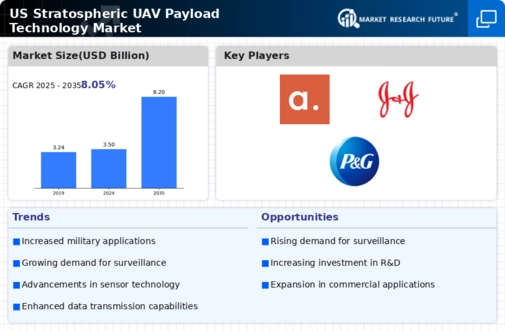Military and Defense Applications
The stratospheric uav-payload-technology market is significantly influenced by military and defense applications. The U.S. Department of Defense has been increasingly investing in UAV technologies for surveillance, reconnaissance, and intelligence-gathering missions. The market is projected to grow as defense budgets allocate more resources towards advanced UAV systems. Reports suggest that the defense sector could account for over 40% of the total market share by 2027. This trend indicates that the stratospheric uav-payload-technology market will continue to thrive, driven by the need for enhanced military capabilities.
Integration with Artificial Intelligence
The integration of artificial intelligence (AI) into the stratospheric uav-payload-technology market is poised to revolutionize data analysis and operational efficiency. AI algorithms can process vast amounts of data collected by UAVs, enabling real-time decision-making and predictive analytics. This technological synergy is likely to enhance the capabilities of UAVs in various applications, including disaster response and agricultural monitoring. As organizations increasingly adopt AI-driven solutions, the stratospheric uav-payload-technology market may witness a growth rate of approximately 15% annually over the next five years.
Growing Interest in Commercial Applications
The stratospheric uav-payload-technology market is experiencing a growing interest in commercial applications, particularly in sectors such as agriculture, logistics, and telecommunications. Businesses are recognizing the potential of UAVs for precision agriculture, supply chain optimization, and enhanced communication services. The market for commercial UAVs is expected to reach $10 billion by 2028, driven by the need for innovative solutions that improve operational efficiency. This trend suggests that the stratospheric uav-payload-technology market will continue to expand as more industries adopt UAV technologies for various applications.
Advancements in Communication Infrastructure
The stratospheric uav-payload-technology market is likely to benefit from advancements in communication infrastructure. As the demand for high-speed internet and reliable communication channels increases, stratospheric UAVs are being utilized to enhance connectivity in remote areas. The Federal Communications Commission has reported that investments in broadband infrastructure could exceed $20 billion in the coming years. This investment is expected to create opportunities for the stratospheric uav-payload-technology market, as these UAVs can serve as relay stations, improving communication capabilities and expanding coverage.
Emerging Applications in Environmental Monitoring
The stratospheric uav-payload-technology market is experiencing a surge in demand due to the increasing need for environmental monitoring. This technology enables the collection of high-resolution data on atmospheric conditions, pollution levels, and climate change indicators. As regulatory bodies emphasize the importance of environmental sustainability, the market is projected to grow significantly. For instance, the U.S. Environmental Protection Agency has indicated that investments in monitoring technologies could reach $1 billion by 2026. This trend suggests that the stratospheric uav-payload-technology market will play a crucial role in supporting environmental initiatives, thereby driving its growth.














Leave a Comment